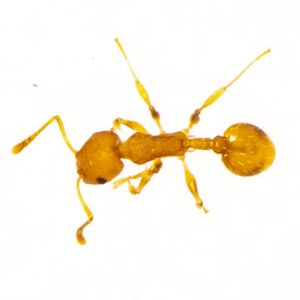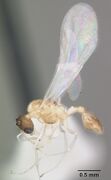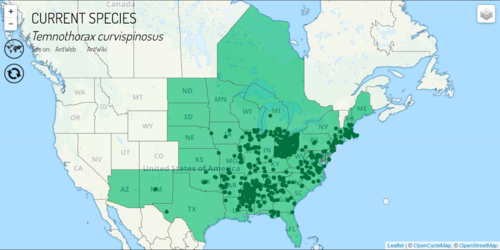Acorn ant
(Temnothorax curvispinosus) or the Acorn ant is one of North America's better studied ant species. Common and widely scattered all over the eastern United States. They are sometimes called the acorn ant because they can live in hollowed out acorns. Acorn ants can be found in both rural and urban areas.

| |
| Kingdom: | Animalia |
|---|---|
| Phylum: | Arthropoda |
| Class: | Insecta |
| Order: | Hymenoptera |
| Family: | Formicidae |
| Subfamily: | Myrmicinae |
| Tribe: | Crematogastrini |
| Genus: | Temnothorax |
| Species: | T. curvispinosus |
| Source: Bug Guide [1] | |
Description
Temnothorax Curvispinosus or Acorn ants are one of North Americans common ant species. Acorn ants are temperature sensitive and are really small in size. Colonies grow to between 100 and 300 ants. An entire colony can live inside hollow acorns. They are known as passive and are not aggressive. The acorn ant is amber/yellow in color with an 11 segmented antenna, a curved propodeal spine that is spaced closely together. Their middle part of the body (mesosoma) is covered in rough ridges (rugae). Their head has tiny holes or “studs” separate from their eyes.
Habitat
Range
Native to the eastern part of the United State, as far north as Maine, as far south as Florida, and as far west as Arizona. Parts of Canada, specifically Ontario. They occupy temperate and subtropical northern forest.
Nest
Acorn ant nest are usually found in hollow stems, insect galls, puffballs, pinecones, and under rocks or in soil, usually at lower elevations. Nest populations are around 80-100 workers with multiple queens. Nests are polydomous (inhabiting several nests) and can change after any disturbance in or near it.[2] In the summer, colonies can break off from the main nest and build nest in the surrounding area. These colonies can sometimes have multiple queens in each nest or sometimes a nest with just workers and larvae. During the winter, colonies come back together into one nest. About half of the colony is lost in the winter. Ants can either die off or migrate to a new nest and either start or join a new colony. [3]
Reproduction
Acorn ants are polygynous, Worker ants reproduce with queens inside the colony. Larvae are usually found inside a nest at any time of the year. New colonies are formed by multiple queens (Pleometrosis) or a new queen can be adopted into an existing colony.[4] The queen will lay around a dozen eggs in a nest. The eggs hatch into larva, which go through multiple molting stages as they grow. Eventually the larva will metamorphose into a pupa then turn into an adult ant. The queen and male ant have wings while the worker ant, which is female, does not have any wings.



Diet
Acorn Ants are generalists and eat liquid sugars like honeydew on tree and plant leaves. They can carry seeds back to the nest. They also eat protein, small insects like spring tails and dipterans (flies). Foraging is usually done in tandem (one ant leading another ant), is higher in the spring and summer months, and slower in the fall. They do not forage in the winter. [5]
Adaption
Acorn ants are temperature sensitive but colonies that live in urban areas have adapted to tolerate the higher temperatures. The development of cities has caused a rapid rise in environmental temperatures, especially with impervious surfaces. Acorn ants had an evolutionary change in thermal tolerance. Urban population ants exhibited greater heat tolerance under the fast rate of temperature change, and this result was correlated with both faster rates of diurnal temperature rise in urban acorn ant nest sites and more rapid spatial changes in temperature across urban foraging areas. [6]
References
- ↑ “Species Temnothorax Curvispinosus.” BugGuide.Net, https://bugguide.net/node/view/328106/tree.
- ↑ Healey, Christiane I. M., and Stephen C. Pratt. “The Effect of Prior Experience on Nest Site Evaluation by the Ant Temnothorax Curvispinosus.” Animal Behaviour, vol. 76, no. 3, 2008, pp. 893–99, https://doi.org/10.1016/j.anbehav.2008.02.016.
- ↑ Pratt, S.C. Behavioral mechanisms of collective nest-site choice by the ant Temnothorax curvispinosus . Insect. Soc. 52, 383–392 (2005). https://doi.org/10.1007/s00040-005-0823-z
- ↑ Pratt, Stephen C. “Efficiency and Regulation of Recruitment During Colony Emigration by the Ant Temnothorax Curvispinosus.” Behavioral Ecology and Sociobiology, vol. 62, no. 8, 2008, pp. 1369–76, https://doi.org/10.1007/s00265-008-0565-9.
- ↑ Mackay, W. P. (2000). "A review of the New World ants of the subgenus Myrafant, (genus Leptothorax) (Hymenoptera: Formicidae)". Sociobiology. 36: 265–444
- ↑ Diamond, Sarah E; Chick, Lacy D; Perez, Abe; Strickler, Stephanie A; Zhao, Crystal (14 June 2018). "Evolution of plasticity in the city: urban acorn ants can better tolerate more rapid increases in environmental temperature". Conservation Physiology. 6 (1): coy030. doi:10.1093/conphys/coy030. ISSN 2051-1434. PMC 6007456. PMID 29977563.
- ↑ Bender, Eric (21 March 2022). "Urban evolution: How species adapt to survive in cities". Knowable Magazine. Annual Reviews. doi:10.1146/knowable-031822-1.
- ↑ Tate Holbrook. "Individual Life Cycle of Ants". ASU - Ask A Biologist. 17 Dec 2009. ASU - Ask A Biologist, Web. 4 May 2023. https://askabiologist.asu.edu/individual-life-cycle
- ↑ “Temnothorax Species - Acorn Ants.” Ant Antics, https://www.antantics.co.uk/product-page/temnothorax-species-acorn-ants
- ↑ “Acorn Ants and Allies (Genus Temnothorax).” INaturalist United Kingdom, https://uk.inaturalist.org/taxa/424607-Temnothorax#cite_note-Snelling_et_al_2014-5
